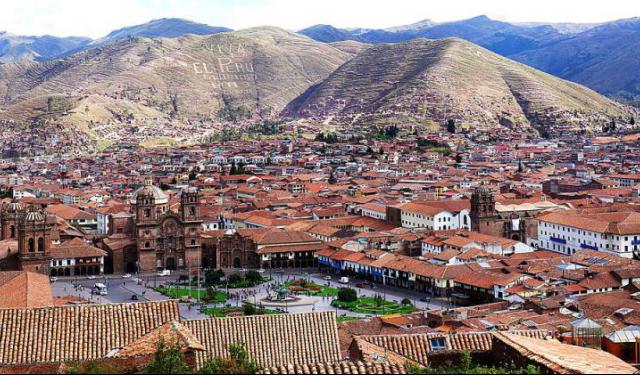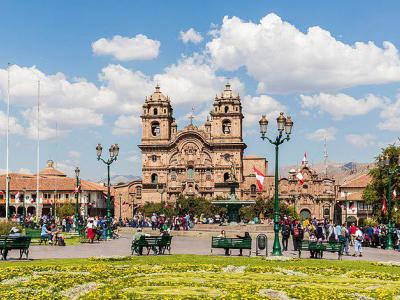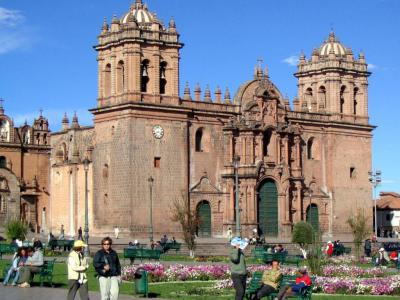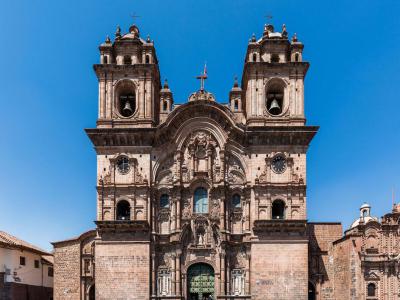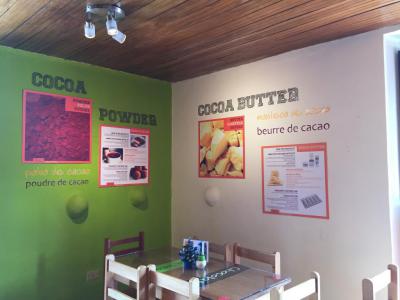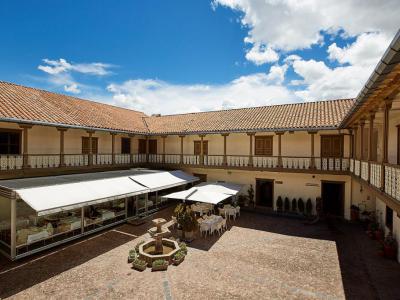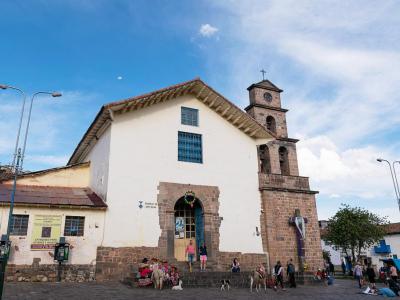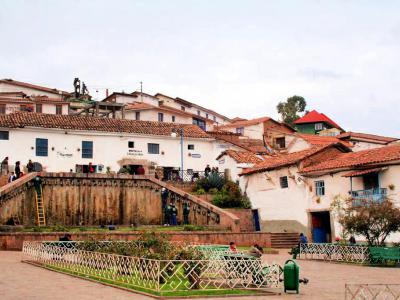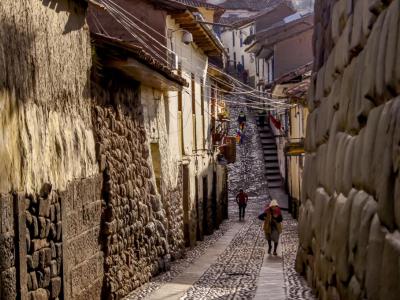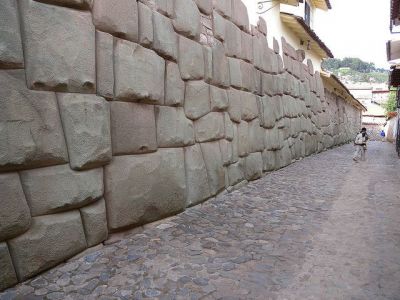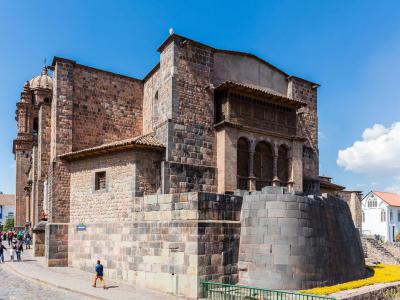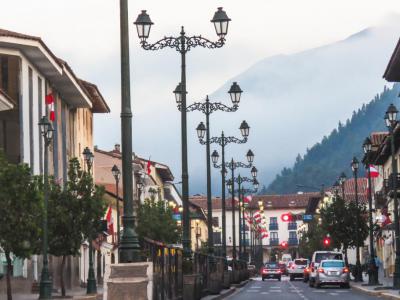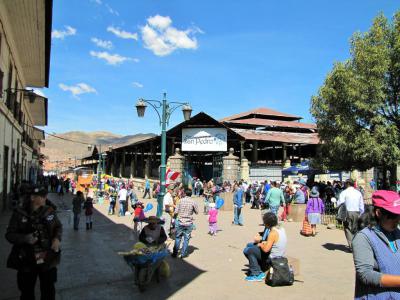Cusco Introduction Walking Tour (Self Guided), Cusco
Nestled high in the Andes mountains, Cusco is a city bursting with stories to tell. Peru's historic capital city was also the Inca Empire's center until the Spanish conquistadors arrived.
Before the Inca settled in the area, the Killke people were here from the years 900 to 1200. Sacsayhuaman, a walled complex outside of town, was built as a fortress by the Killke.
The Inca later expanded the complex in the 13th century by adding temples, roadways, and an aqueduct system. Cusco became the center of their empire. Back then, the city was divided into quadrants, and each quadrant had a road that led to the corresponding quarter of the empire.
Evidence of the Inca's incredible stonework can be seen throughout the city, not just in Sacsayhuaman. Don't miss the Archibishop Palace, the famous Twelve-Angle Stone, and Coricancha. You can also learn more about the Inca's amazing building skills and art at the Pre-Columbian Art Museum.
Other stories of Cusco's past come from evidence of Spanish architecture. The Cusco Cathedral, the Church of the Company of Jesus, and the San Blas Church all feature stunning Spanish colonial architecture. Many colonial structures used the Inca's timeless stonework as a base.
Since 1983, Cusco has been a UNESCO World Heritage Site, and over two million visitors explore the city every year. Grab a bite or a souvenir at the San Pedro Central Market, and then stop by the ChocoMuseo to learn more about the region's connection to the cocoa bean.
Start your explorations of Cusco from its historical center, the Plaza de Armas. Stroll down Hatun Rumiyoq Street, one of the Inca empire's original roads. Everywhere you look, you'll find stunning views and friendly smiles. Get ready to meet new friends and be inspired by this incredible city. Follow this self-guided walking tour and see the best that Cusco has to offer.
Before the Inca settled in the area, the Killke people were here from the years 900 to 1200. Sacsayhuaman, a walled complex outside of town, was built as a fortress by the Killke.
The Inca later expanded the complex in the 13th century by adding temples, roadways, and an aqueduct system. Cusco became the center of their empire. Back then, the city was divided into quadrants, and each quadrant had a road that led to the corresponding quarter of the empire.
Evidence of the Inca's incredible stonework can be seen throughout the city, not just in Sacsayhuaman. Don't miss the Archibishop Palace, the famous Twelve-Angle Stone, and Coricancha. You can also learn more about the Inca's amazing building skills and art at the Pre-Columbian Art Museum.
Other stories of Cusco's past come from evidence of Spanish architecture. The Cusco Cathedral, the Church of the Company of Jesus, and the San Blas Church all feature stunning Spanish colonial architecture. Many colonial structures used the Inca's timeless stonework as a base.
Since 1983, Cusco has been a UNESCO World Heritage Site, and over two million visitors explore the city every year. Grab a bite or a souvenir at the San Pedro Central Market, and then stop by the ChocoMuseo to learn more about the region's connection to the cocoa bean.
Start your explorations of Cusco from its historical center, the Plaza de Armas. Stroll down Hatun Rumiyoq Street, one of the Inca empire's original roads. Everywhere you look, you'll find stunning views and friendly smiles. Get ready to meet new friends and be inspired by this incredible city. Follow this self-guided walking tour and see the best that Cusco has to offer.
How it works: Download the app "GPSmyCity: Walks in 1K+ Cities" from Apple App Store or Google Play Store to your mobile phone or tablet. The app turns your mobile device into a personal tour guide and its built-in GPS navigation functions guide you from one tour stop to next. The app works offline, so no data plan is needed when traveling abroad.
Cusco Introduction Walking Tour Map
Guide Name: Cusco Introduction Walking Tour
Guide Location: Peru » Cusco (See other walking tours in Cusco)
Guide Type: Self-guided Walking Tour (Sightseeing)
# of Attractions: 12
Tour Duration: 2 Hour(s)
Travel Distance: 3.3 Km or 2.1 Miles
Author: Nick
Sight(s) Featured in This Guide:
Guide Location: Peru » Cusco (See other walking tours in Cusco)
Guide Type: Self-guided Walking Tour (Sightseeing)
# of Attractions: 12
Tour Duration: 2 Hour(s)
Travel Distance: 3.3 Km or 2.1 Miles
Author: Nick
Sight(s) Featured in This Guide:
- Plaza de Armas (Main Square)
- Cusco Cathedral
- Church of the Company of Jesus
- ChocoMuseo (Chocolate Museum)
- Pre-Columbian Art Museum
- San Blas Church
- San Blas Square and District
- Hatun Rumiyoq Street
- Archbishop Palace and Twelve-Angle Stone
- Coricancha and Convent of Santo Domingo
- Avenida El Sol (Sun Avenue)
- San Pedro Central Market
1) Plaza de Armas (Main Square) (must see)
Main Square is Cusco's central hub of activity. Main Square has a colonial look, but the area has been central to human settlements since the Inca Empire. Here, the Inca army celebrated victories, and the residents held ceremonies. Back then, the square was known as the "Square of the Warrior".
Before Main Square was a meeting place, it was a swamp. Legendary Manco Capac, the founder of the Inca civilization in Cusco, built a palace and a city around the swamp. Then, his son began drying the swamp, and the area became a central location.
During the Inca era, the square was the center of the Inca Empire. The square was larger than it is today and was home to administrative and religious activities in addition to fairs and festivals. Impressive palaces lined the square.
The Spanish arrived in the early 1500s and took over the palaces. The Spanish built chapels, cathedrals, and mansions over the Inca palaces. Today's buildings feature colonial architecture with Inca foundations and some Inca walls.
Main Square has a beautiful central fountain. It is surrounded by impressive landmark buildings such as the Cusco Cathedral, the Church of the Company of Jesus, and the Chapel of Triumph. In addition, the square features many museums, restaurants, cafes, bars, and shops. Main Square hosts parades, festivals, and celebrations.
The square features a statue celebrating Jose Gabriel Tupac Amaru. He fought for independence from the Spanish but was publicly executed in the square as a warning to other residents.
Before Main Square was a meeting place, it was a swamp. Legendary Manco Capac, the founder of the Inca civilization in Cusco, built a palace and a city around the swamp. Then, his son began drying the swamp, and the area became a central location.
During the Inca era, the square was the center of the Inca Empire. The square was larger than it is today and was home to administrative and religious activities in addition to fairs and festivals. Impressive palaces lined the square.
The Spanish arrived in the early 1500s and took over the palaces. The Spanish built chapels, cathedrals, and mansions over the Inca palaces. Today's buildings feature colonial architecture with Inca foundations and some Inca walls.
Main Square has a beautiful central fountain. It is surrounded by impressive landmark buildings such as the Cusco Cathedral, the Church of the Company of Jesus, and the Chapel of Triumph. In addition, the square features many museums, restaurants, cafes, bars, and shops. Main Square hosts parades, festivals, and celebrations.
The square features a statue celebrating Jose Gabriel Tupac Amaru. He fought for independence from the Spanish but was publicly executed in the square as a warning to other residents.
2) Cusco Cathedral (must see)
The Cusco Cathedral is part of Cusco's UNESCO World Heritage Site. The Spanish built the Cusco Cathedral between 1560 and 1654. The Roman Catholic church is Main Square's most impressive building. It has a Spanish colonial style and is home to significant colonial artworks as well as archeological finds.
The Cusco Cathedral replaced an Inca temple and was built on the temple's foundations. Many of the cathedral's stones are from the Sacsayhuamán citadel on the northern outskirts of the city. The Spanish also used the square's sacred sand in the construction. The Cusco Cathedral features a classic colonial Gothic-Renaissance style. The Spanish used conquered residents as their labor, and included some Inca symbols in the cathedral, such as the carved jaguar head on the doors.
The cathedral's north tower features the remarkable Maria Angola Bell. The bell was cast in 1659, is 2.15 meters (seven feet) high, and weighs over 13,000 pounds. The bell was named after an Angola enslaved person who added gold to the crucible when the bell was created. The bell is audible up to 20 miles away but is only rung for special occasions.
Visitors will find a collection of Peruvian painter Marcos Zapata's paintings in the sacristy. A highlight of Zapata's paintings is the fascinating "The Last Supper" showing Jesus and his disciples eating traditional Peruvian dishes such as guinea pig and and drinking chicha. Zapata was born in Cusco and was known for introducing local elements in his paintings.
In addition, the cathedral hosts portraits of Cusco's bishops. The cathedral also displays works from the Cusco School of Art. The wooden Christ of the Earthquakes crucifix is tarnished with centuries of candle smoke. The crucifix is taken outdoors during Holy Week to commemorate the 1650 earthquake.
The Cusco Cathedral replaced an Inca temple and was built on the temple's foundations. Many of the cathedral's stones are from the Sacsayhuamán citadel on the northern outskirts of the city. The Spanish also used the square's sacred sand in the construction. The Cusco Cathedral features a classic colonial Gothic-Renaissance style. The Spanish used conquered residents as their labor, and included some Inca symbols in the cathedral, such as the carved jaguar head on the doors.
The cathedral's north tower features the remarkable Maria Angola Bell. The bell was cast in 1659, is 2.15 meters (seven feet) high, and weighs over 13,000 pounds. The bell was named after an Angola enslaved person who added gold to the crucible when the bell was created. The bell is audible up to 20 miles away but is only rung for special occasions.
Visitors will find a collection of Peruvian painter Marcos Zapata's paintings in the sacristy. A highlight of Zapata's paintings is the fascinating "The Last Supper" showing Jesus and his disciples eating traditional Peruvian dishes such as guinea pig and and drinking chicha. Zapata was born in Cusco and was known for introducing local elements in his paintings.
In addition, the cathedral hosts portraits of Cusco's bishops. The cathedral also displays works from the Cusco School of Art. The wooden Christ of the Earthquakes crucifix is tarnished with centuries of candle smoke. The crucifix is taken outdoors during Holy Week to commemorate the 1650 earthquake.
3) Church of the Company of Jesus
The Church of the Company of Jesus was built on an Inca palace. Jesuits began construction on the church in 1576. The church features Spanish Baroque architecture. Its beautiful architecture influenced many other buildings later on.
The church was damaged during the 1650 earthquake and rebuilt in 1668. The church has ornate exterior and interior embellishments, such as a dramatic portal and exquisite altarpieces. The nearby Cusco Cathedral's leaders became concerned about the church's attractive features and wanted the church to tone it down so the cathedral could remain Cusco's most magnificent landmark. Pope Paul III was asked to intervene. However, his support of the cathedral didn't reach Cusco until the Church of the Company of Jesus was completed.
The Church of the Company of Jesus features several interesting artworks. Visitors will find a painting showing the wedding of Ignatius Loyola's nephew Martin Garcia de Loyola with Inca ruler Tupac Amaru's grand-niece Beatriz. Ignatius Loyola founded the Company of Jesus, and Tupac Amaru was the last Inca ruler.
The church was damaged during the 1650 earthquake and rebuilt in 1668. The church has ornate exterior and interior embellishments, such as a dramatic portal and exquisite altarpieces. The nearby Cusco Cathedral's leaders became concerned about the church's attractive features and wanted the church to tone it down so the cathedral could remain Cusco's most magnificent landmark. Pope Paul III was asked to intervene. However, his support of the cathedral didn't reach Cusco until the Church of the Company of Jesus was completed.
The Church of the Company of Jesus features several interesting artworks. Visitors will find a painting showing the wedding of Ignatius Loyola's nephew Martin Garcia de Loyola with Inca ruler Tupac Amaru's grand-niece Beatriz. Ignatius Loyola founded the Company of Jesus, and Tupac Amaru was the last Inca ruler.
4) ChocoMuseo (Chocolate Museum) (must see)
Peru is the world's ninth largest cacao producer and the world's largest organic cacao producer. Chocolate Museum celebrates Peru's chocolate culture. The museum features a delightful assortment of chocolates available to purchase. Visitors can learn about chocolate's history in Peru. Staff will show you around the museum and explain the chocolate-making process from harvest to store. In addition, visitors can taste the delicious chocolate made with organic local cocoa beans.
Guests can attend a Bean to Bar Workshop and craft their own chocolate creations. The workshop reviews the history of chocolate and its importance in Peruvian culture. Guests will start with cacao beans and learn how to make custom chocolates--or even Mayan-inspired cocoa drinks.
Chocolate Museum also hosts a cooking class. During the class, guests will go shopping with an experienced guide. Then, create a delicious Peruvian meal with guidance from an expert chef. Finally, you can dive into your culinary creation and taste other students' dishes.
Guests can attend a Bean to Bar Workshop and craft their own chocolate creations. The workshop reviews the history of chocolate and its importance in Peruvian culture. Guests will start with cacao beans and learn how to make custom chocolates--or even Mayan-inspired cocoa drinks.
Chocolate Museum also hosts a cooking class. During the class, guests will go shopping with an experienced guide. Then, create a delicious Peruvian meal with guidance from an expert chef. Finally, you can dive into your culinary creation and taste other students' dishes.
5) Pre-Columbian Art Museum
The Pre-Columbian Art Museum is located in an Inca building that may have originally housed a school. The building was rebuilt in the Spanish colonial style in 1580 and became an orphanage.
The Pre-Columbian Art Museum features pre-Columbian artworks from 1250 BC to AD 1532. The museum has 400 artworks in ten galleries.
The Origins Gallery features the oldest artworks. It includes engraved ceramic bottles, decorated jugs, and ceramic sculptures. The Wood Gallery houses wood sculptures that represent dead ancestors.
The Shell Gallery has shell necklaces and an intricately carved bone pin. Andean cultures found silver to be feminine, and guests will find beautiful nose rings and earrings in the Silver Gallery. The Gold Gallery also features delicate and elegant gold earrings.
The South Peru Gallery features artworks from the Nasca culture. Artworks on display include painted ceramic bottles, vases, and jugs. The North Peru Gallery also features ceramic sculptures and jugs. Finally, the Central Peru Gallery focuses on Huari society and its symbolic artworks.
Finally, the Inca Gallery has carved alpacas, wooden keros used for toasts, and exquisite ceramic monumental vessels.
The Pre-Columbian Art Museum features pre-Columbian artworks from 1250 BC to AD 1532. The museum has 400 artworks in ten galleries.
The Origins Gallery features the oldest artworks. It includes engraved ceramic bottles, decorated jugs, and ceramic sculptures. The Wood Gallery houses wood sculptures that represent dead ancestors.
The Shell Gallery has shell necklaces and an intricately carved bone pin. Andean cultures found silver to be feminine, and guests will find beautiful nose rings and earrings in the Silver Gallery. The Gold Gallery also features delicate and elegant gold earrings.
The South Peru Gallery features artworks from the Nasca culture. Artworks on display include painted ceramic bottles, vases, and jugs. The North Peru Gallery also features ceramic sculptures and jugs. Finally, the Central Peru Gallery focuses on Huari society and its symbolic artworks.
Finally, the Inca Gallery has carved alpacas, wooden keros used for toasts, and exquisite ceramic monumental vessels.
6) San Blas Church
The San Blas Church was built on an Incan temple dedicated to the god of thunder and lightning. The church was originally built in the mid-1500s and rebuilt after the 1650 earthquake.
The San Blas Church has a simple adobe facade, but the interior is stunning and features many famous artworks. The artworks and famous altar were added after the 1650 earthquake.
The ornate Baroque altar was carved from a single piece of cedar. The gold-leaf altar is thought to be one of the most elaborate carvings in the Americas. A popular legend tells that the altar was carved by an indigenous person who recovered from a deadly illness and dedicated his life to serving the church. The legend also says that the carver's skull was embedded in the altar after his death.
The church hosts several beautiful paintings. For example, Peruvian painter Diego Quispe Tito's painting depicts the resurrection of Lazarus. Tito is considered the leader of the Cuzco School of painting. In addition, the church has various sculptures.
The San Blas Church has a simple adobe facade, but the interior is stunning and features many famous artworks. The artworks and famous altar were added after the 1650 earthquake.
The ornate Baroque altar was carved from a single piece of cedar. The gold-leaf altar is thought to be one of the most elaborate carvings in the Americas. A popular legend tells that the altar was carved by an indigenous person who recovered from a deadly illness and dedicated his life to serving the church. The legend also says that the carver's skull was embedded in the altar after his death.
The church hosts several beautiful paintings. For example, Peruvian painter Diego Quispe Tito's painting depicts the resurrection of Lazarus. Tito is considered the leader of the Cuzco School of painting. In addition, the church has various sculptures.
7) San Blas Square and District (must see)
Uphill and northeast from the Main Square, you'll find the San Blas District of town. The area is known as the artist's quarter, and it has been described as the most picturesque area of town. It's quieter here, too. You'll find great cafes and beautiful views of the rest of Cusco below.
The road up to San Blas Square is called the San Blas Slope. There are numerous art galleries and workshops along the way. Walking here is a pleasure for the senses.
San Blas Square is located in the heart of the area. It's bounded by Carmen Bajo and Calle Tandepata and is dominated by a large fountain. The cobbled streets in the area are steep, built narrow with Inca stone steps.
The Inca called this part of town Salt Cave. Even since those times, this charming barrio has been popular with artisans. It is believed that the area was also popular with the Inca elite.
The district's name changed with the Spaniards, who named it in honor of the third-century bishop who dedicated his time to healing people and animals.
There are two attractions on the square that you won't want to miss. The first is the San Blas Church. The second is the Hilario Mendivil and Family Gallery. Mendivil is a well-known artist from the area known for his religious imagery.
The road up to San Blas Square is called the San Blas Slope. There are numerous art galleries and workshops along the way. Walking here is a pleasure for the senses.
San Blas Square is located in the heart of the area. It's bounded by Carmen Bajo and Calle Tandepata and is dominated by a large fountain. The cobbled streets in the area are steep, built narrow with Inca stone steps.
The Inca called this part of town Salt Cave. Even since those times, this charming barrio has been popular with artisans. It is believed that the area was also popular with the Inca elite.
The district's name changed with the Spaniards, who named it in honor of the third-century bishop who dedicated his time to healing people and animals.
There are two attractions on the square that you won't want to miss. The first is the San Blas Church. The second is the Hilario Mendivil and Family Gallery. Mendivil is a well-known artist from the area known for his religious imagery.
8) Hatun Rumiyoq Street
Hatun Rumiyoc Street in Cusco stands as a testament to the architectural prowess of the ancient Inca civilization. This well-preserved, narrow cobbled pedestrian street once served as a pathway to the Antisuyu quarter of the Inca Empire and features some of the most iconic remnants of Inca engineering. The street is famous for the Twelve-Angled Stone, a marvel of stonework located roughly at its midpoint. This intricately carved stone boasts twelve corners and fits seamlessly with the surrounding stones without the use of mortar, a testament to the precision of Inca craftsmanship.
The historical significance of Hatun Rumiyoc Street is further underscored by the remnants of Inka Roca Palace, an impressive wall that dominates much of the street. This site once served as a palace for Inca nobility before being taken over by Spanish conquerors and later transformed into the Archbishop’s Palace in the early 20th century. Today, it houses Cusco’s Religious Art Museum, which showcases works from the Escuela Cusqueña period.
The street offers a unique visual experience, particularly striking under the street lights at night, which highlight the three-dimensional aspect of the ancient stones, providing excellent photographic opportunities. During the day, visitors can capture a moment with an Inca in traditional attire, near the Twelve-Angled Stone, for a small fee. The street's journey ends at its intersection with Choquechaca Street (Calle Choquechaca), where it transitions into a narrow road leading into the San Blas district, continuing its uphill route amidst modern vehicular traffic. Hatun Rumiyoc Street not only reflects the historical and cultural heritage of Cusco but also offers a blend of ancient allure and contemporary life.
The historical significance of Hatun Rumiyoc Street is further underscored by the remnants of Inka Roca Palace, an impressive wall that dominates much of the street. This site once served as a palace for Inca nobility before being taken over by Spanish conquerors and later transformed into the Archbishop’s Palace in the early 20th century. Today, it houses Cusco’s Religious Art Museum, which showcases works from the Escuela Cusqueña period.
The street offers a unique visual experience, particularly striking under the street lights at night, which highlight the three-dimensional aspect of the ancient stones, providing excellent photographic opportunities. During the day, visitors can capture a moment with an Inca in traditional attire, near the Twelve-Angled Stone, for a small fee. The street's journey ends at its intersection with Choquechaca Street (Calle Choquechaca), where it transitions into a narrow road leading into the San Blas district, continuing its uphill route amidst modern vehicular traffic. Hatun Rumiyoc Street not only reflects the historical and cultural heritage of Cusco but also offers a blend of ancient allure and contemporary life.
9) Archbishop Palace and Twelve-Angle Stone
You'll find the Archbishop Palace and the Twelve-Angled Stone along Hatun Rumiyoq Street. The most impressive part of the walk up the street is the Inca stone walls that make up the palace.
The Twelve-Angled Stone is part of the palace wall. It's noted for its fine finishing and stands as a testament to the advanced stonework created by the Inca. While other stones have as many angles, this is the best-known twelve-angle stone.
The palace was home to the sixth Inca emperor, Inca Roca. After the Spanish conquest, it was dismantled and rebuilt into farmhouses for Spanish landowners. It features a Renaissance courtyard with arches. A large pool and decorative tiles round out the colonial features added.
Today, the palace is home to the Religious Art Museum. In addition to the Twelve-Angle Stone, you can view a collection of colonial religious paintings. Several Andean paintings by masters like Juan Zapata are also on display. The structure is also beautiful, full of carved cedar ceilings, Moorish-style doors, and gorgeous stained glass windows.
The Twelve-Angled Stone is part of the palace wall. It's noted for its fine finishing and stands as a testament to the advanced stonework created by the Inca. While other stones have as many angles, this is the best-known twelve-angle stone.
The palace was home to the sixth Inca emperor, Inca Roca. After the Spanish conquest, it was dismantled and rebuilt into farmhouses for Spanish landowners. It features a Renaissance courtyard with arches. A large pool and decorative tiles round out the colonial features added.
Today, the palace is home to the Religious Art Museum. In addition to the Twelve-Angle Stone, you can view a collection of colonial religious paintings. Several Andean paintings by masters like Juan Zapata are also on display. The structure is also beautiful, full of carved cedar ceilings, Moorish-style doors, and gorgeous stained glass windows.
10) Coricancha and Convent of Santo Domingo (must see)
The Coricancha, "Golden Temple" or sometimes "Temple of the Sun," was the most important temple in the Inca Empire. Unfortunately, most of the temple was destroyed by Spanish conquistadors, but the remaining stonework was used to make the foundation of the Santo Domingo Convent.
You'll notice many variations of spelling used for "Coricancha" since there is no single agreed-upon English spelling. A few alternatives that you'll see include Qorikancha and Koricancha.
The Inca used ashlar masonry to construct Coricancha. This alone is a testament to the building's importance since ashlar is labor intensive and requires the use of only perfectly faced and squared stones.
At one time, the walls of Coricancha were covered in gold, and the courtyards were filled with gold statues. The Spanish described the opulence as "fabulous beyond belief." In 1533, the Spanish demanded a gold ransom for the Inca leader Atahualpa's life. Most of the gold came from Coricancha. A nearby archaeological museum has a collection of mummies, idols, and textiles from the site.
The Spanish eventually built the Convent of Santo Domingo on the site. Some of the stones from Coricancha were used for the foundation, and others found their way into other churches around town.
The convent was the first Dominican convent in Peru. It was founded in 1534, and the first building was completed in 1610. Unfortunately, a severe earthquake caused an earlier structure to collapse completely.
The building you see today was built in 1680. The baroque bell tower was added in the early 1700s. The museum here is divided into four areas: the Coricancha, the Cusco School, a contemporary art collection, and a collection of work collected by the convent to recognize modern works made in the city of Cusco.
You'll notice many variations of spelling used for "Coricancha" since there is no single agreed-upon English spelling. A few alternatives that you'll see include Qorikancha and Koricancha.
The Inca used ashlar masonry to construct Coricancha. This alone is a testament to the building's importance since ashlar is labor intensive and requires the use of only perfectly faced and squared stones.
At one time, the walls of Coricancha were covered in gold, and the courtyards were filled with gold statues. The Spanish described the opulence as "fabulous beyond belief." In 1533, the Spanish demanded a gold ransom for the Inca leader Atahualpa's life. Most of the gold came from Coricancha. A nearby archaeological museum has a collection of mummies, idols, and textiles from the site.
The Spanish eventually built the Convent of Santo Domingo on the site. Some of the stones from Coricancha were used for the foundation, and others found their way into other churches around town.
The convent was the first Dominican convent in Peru. It was founded in 1534, and the first building was completed in 1610. Unfortunately, a severe earthquake caused an earlier structure to collapse completely.
The building you see today was built in 1680. The baroque bell tower was added in the early 1700s. The museum here is divided into four areas: the Coricancha, the Cusco School, a contemporary art collection, and a collection of work collected by the convent to recognize modern works made in the city of Cusco.
11) Avenida El Sol (Sun Avenue)
Sun Avenue (Avenida El Sol) is a pivotal artery in Cusco, known for its vibrant blend of commerce, history, and tourism. Stretching from northwest to southeast across the city's Historic Center, this major avenue follows the course of the once visible Saphy River, which was channelized during the Inca era. Today, the avenue is a bustling hub encircled by an array of shops, restaurants, hotels, and tourist-centric enterprises.
Proximate to key attractions like the Main Square (Plaza de Armas), the Cathedral of Cusco, and the Temple of the Sun, Sun Avenue is not just a tourist destination but also a central part of local life. It serves as a main conduit for the city's public transportation, with ample bus and taxi services, especially during the peak tourist season when it often experiences heavy traffic congestion.
Originally the channeled bed of the Saphy River, Sun Avenue transformed into a major thoroughfare between 1911 and 1931. By 1927, it was fully established up to Wanchaq Station. The construction of the Municipal Theater in 1930 and other key developments marked its growth as the city's main street. By 1940, it was paved and became home to institutional buildings like the Gibson Bank, Popular and Agropecuario Bank, Cusco Club, and Savoy Hotel.
Sun Avenue's historical and cultural importance has been recognized both nationally and internationally. Since 1972, it has been part of the Monumental Zone of Cusco, declared a Historical Monument of Peru. Furthermore, in 1983, as part of the historic center of Cusco, it was included in the area declared by UNESCO as a Cultural Heritage of Humanity. In 2014, it gained additional recognition when it was incorporated into the Tawantinsuyo road network, again declared a World Heritage Site.
Proximate to key attractions like the Main Square (Plaza de Armas), the Cathedral of Cusco, and the Temple of the Sun, Sun Avenue is not just a tourist destination but also a central part of local life. It serves as a main conduit for the city's public transportation, with ample bus and taxi services, especially during the peak tourist season when it often experiences heavy traffic congestion.
Originally the channeled bed of the Saphy River, Sun Avenue transformed into a major thoroughfare between 1911 and 1931. By 1927, it was fully established up to Wanchaq Station. The construction of the Municipal Theater in 1930 and other key developments marked its growth as the city's main street. By 1940, it was paved and became home to institutional buildings like the Gibson Bank, Popular and Agropecuario Bank, Cusco Club, and Savoy Hotel.
Sun Avenue's historical and cultural importance has been recognized both nationally and internationally. Since 1972, it has been part of the Monumental Zone of Cusco, declared a Historical Monument of Peru. Furthermore, in 1983, as part of the historic center of Cusco, it was included in the area declared by UNESCO as a Cultural Heritage of Humanity. In 2014, it gained additional recognition when it was incorporated into the Tawantinsuyo road network, again declared a World Heritage Site.
12) San Pedro Central Market (must see)
San Pedro Central Market in Cusco is a vibrant and bustling hub that encapsulates the rich cultural tapestry of the region. Dating back to colonial times, the market originally served as a gathering spot for various merchants on the streets of Cusco. Over the years, it has undergone architectural transformations to become a more organized and clean space, attracting not only locals but also tourists from around the world.
Located just a short walk from the Main Square (Plaza de Armas) in Cusco, the market offers a genuine glimpse into the daily lives and customs of the Cusqueñians. It is especially renowned for its eclectic array of foods, including local delicacies like chicharrones made from pig heads, sheep head soup, and more exotic offerings such as frog juice, believed to boost intelligence.
For those interested in traditional crafts and souvenirs, San Pedro is a treasure trove. The market features a wide range of textiles made from alpaca, llama, and sheep wool, often blended with synthetic materials. It also offers ceramics, leather goods, and a variety of hand-made items, all available at negotiable prices, providing a perfect opportunity for bargain hunters.
Additionally, the market is a fantastic place to explore Peruvian biodiversity, with a section dedicated to local fruits that were domesticated by the Incas. Visitors can try rare fruits like chirimoya, lucuma, and granadilla, and learn about their uses and significance.
San Pedro Market also serves as a cultural center where visitors can observe traditional rituals and offerings to Pachamama (Mother Earth), including the sale of llama and alpaca fetuses, old coins, and incense.
A visit to San Pedro Central Market offers an authentic slice of everyday life in Cusco, making it a must-visit destination for those looking to immerse themselves in the local culture and gastronomy.
Located just a short walk from the Main Square (Plaza de Armas) in Cusco, the market offers a genuine glimpse into the daily lives and customs of the Cusqueñians. It is especially renowned for its eclectic array of foods, including local delicacies like chicharrones made from pig heads, sheep head soup, and more exotic offerings such as frog juice, believed to boost intelligence.
For those interested in traditional crafts and souvenirs, San Pedro is a treasure trove. The market features a wide range of textiles made from alpaca, llama, and sheep wool, often blended with synthetic materials. It also offers ceramics, leather goods, and a variety of hand-made items, all available at negotiable prices, providing a perfect opportunity for bargain hunters.
Additionally, the market is a fantastic place to explore Peruvian biodiversity, with a section dedicated to local fruits that were domesticated by the Incas. Visitors can try rare fruits like chirimoya, lucuma, and granadilla, and learn about their uses and significance.
San Pedro Market also serves as a cultural center where visitors can observe traditional rituals and offerings to Pachamama (Mother Earth), including the sale of llama and alpaca fetuses, old coins, and incense.
A visit to San Pedro Central Market offers an authentic slice of everyday life in Cusco, making it a must-visit destination for those looking to immerse themselves in the local culture and gastronomy.
Walking Tours in Cusco, Peru
Create Your Own Walk in Cusco
Creating your own self-guided walk in Cusco is easy and fun. Choose the city attractions that you want to see and a walk route map will be created just for you. You can even set your hotel as the start point of the walk.
Cusco's Historical Churches
Cusco, the former capital of the Inca Empire, is one of the oldest cities in the world. In the 16th century, Spanish missionaries introduced the area to Catholicism. The result of that has been a plethora of historical churches built in the city since.
Among the marvels of local ecclesiastical architecture, the Cusco Cathedral reigns supreme. Constructed on the foundations of an Inca temple,... view more
Tour Duration: 1 Hour(s)
Travel Distance: 2.1 Km or 1.3 Miles
Among the marvels of local ecclesiastical architecture, the Cusco Cathedral reigns supreme. Constructed on the foundations of an Inca temple,... view more
Tour Duration: 1 Hour(s)
Travel Distance: 2.1 Km or 1.3 Miles
The Most Popular Cities
/ view all
